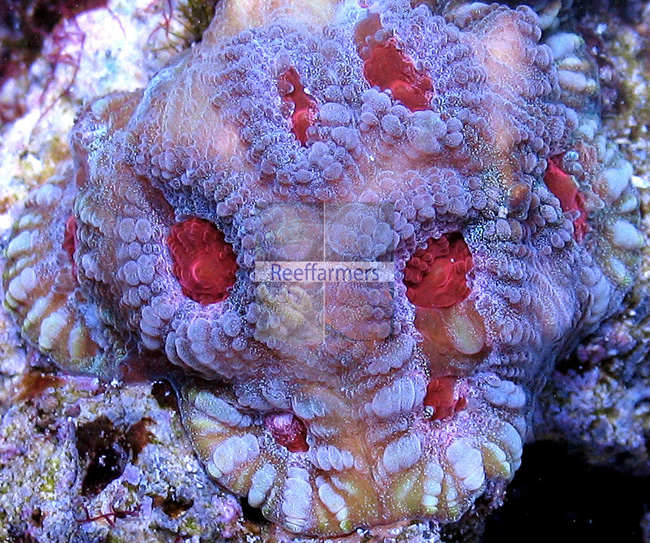 TM
TM
 TM
TM
|
Limited Edition
|
 |
Eye of Jupiter Favia Reeffarmers Seed Colony. We have been maintaining
our seed section under moderate to weak light levels |
SniperSPS and Jose Casas found the coral in the Orange County California Reef Shop called Eye Candy. Allen of Eye Candy sold the entire colony, but at that time is was being maintained within low light (see second image below). When maintained in very low to low light conditions the coral develops a solid blue purple coloration with bright red/orange corallite centers. That is the appearence from which SniperSPS named the coral the Eye of Jupiter.
Steve of Reeffarmers noticed this coral in the reef of SniperSPS during a visit in December of 2007. What was very interesting about the coral was the thick rays radiating from the corallite centers that could be seen on a few leading edge corallites (see upper left of second image below). Upon being placed within a Reeffarmers high organic nutrient system with slightly stronger light, the blue purple pigments faded between the corallites and were eventually replaced by pink pigments. Pink also developed within the inner corallite walls. The white rows of radiating spots also developed more fully on many more of the corallites (see image above). SniperSPS has only distributed one fragment prior to the corals AE listing. Jose Casas distributed a few fragments at the 2008 SW-CFM event.
Steve Tyree is maintaining a seed section of the Eye of Jupiter Favia for Reeffarmers.com in an 125 gallon naturally filtered Tri-Zonal Reef Aquarium. In Steve's captive reef the coral is positioned to receive weak to moderate light under a 400 watt 20,000 K Radium Metal Halide. The coral only needs weak to moderate illumination to maintain its coloration. The price is currently $80 per two corallites.
Please note Reeffarmers is no longer taking new reservations for new corals. The current economic conditions are not supportive for reservations that extend for a few years into the future. After this first edition is distributed, we will sell future captive produced fragments on either our Buy It Now page or via another silent auction. We will still list exotic corals as Limited Editions and will continue to build web pages for them.
 |
||||||||||||||||||
Eye of Jupiter Favia Reeffarmers Seed Corallite Closeup. | ||||||||||||||||||
 |
||||||||||||||||
SniperSPS Eye of Jupiter Seed Colony. When maintained under very low light conditions
the main surface of the coral | ||||||||||||||||
Auction |
|
Auction |
|
Auction |
|
Auction |
|
Auction |
|
Auction |
|
